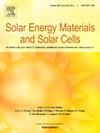Defect detection in III-V multijunction solar cells using reverse-bias stress tests
IF 6.3
2区 材料科学
Q2 ENERGY & FUELS
引用次数: 0
Abstract
Reverse biasing triple-junction GaInP/Ga(In)As/Ge solar cells may affect their performance by the formation of permanent shunts even if the reverse breakdown voltage is not reached. In previous works, it was observed that, amid the three components, GaInP subcells are more prone to degrade when reverse biased suffering permanent damage, although they present an initial good performance. The aim of this work is, firstly, to study the characteristics of the defects that cause the catastrophic failure of the devices. For this, GaInP isotype solar cells were analysed by visual inspection and electroluminescence maps and submitted to reverse bias stress test. We find that specific growth defects (i.e. hillocks), when covered with metal, cause the degradation in the cells. SEM cross-section imaging and EDX compositional analysis of these defects reveal their complex structures, which in essence consist of material abnormally grown on and around particles present on the wafer surface before growth. The reverse bias stress test is proposed as a screening method to spot defects hidden under the metal that may not be detected by conventional screening methods. By applying a quick reverse bias stress test, we can detect those defects that cause the degradation of devices at voltages below the breakdown voltage and that may also affect their long-term reliability.
利用反向偏压测试检测 III-V 多结太阳能电池中的缺陷
对三重结 GaInP/Ga(In)As/Ge 太阳能电池进行反向偏压,即使没有达到反向击穿电压,也可能会形成永久分流,从而影响其性能。在以前的研究中,我们发现,在这三种成分中,GaInP 子电池在反向偏压时更容易退化,遭受永久性损坏,尽管它们最初性能良好。这项工作的目的首先是研究导致器件灾难性失效的缺陷特征。为此,我们通过目测和电致发光图分析了 GaInP 异型太阳能电池,并对其进行了反向偏压测试。我们发现,特定的生长缺陷(即山丘)在被金属覆盖后会导致电池降解。对这些缺陷的 SEM 截面成像和 EDX 成分分析揭示了它们的复杂结构,其实质是由异常生长在生长前晶片表面颗粒上和颗粒周围的材料组成。反向偏置应力测试是一种筛选方法,用于发现隐藏在金属下的缺陷,传统筛选方法可能无法检测到这些缺陷。通过快速反向偏压应力测试,我们可以检测出那些在电压低于击穿电压时会导致器件性能下降并可能影响其长期可靠性的缺陷。
本文章由计算机程序翻译,如有差异,请以英文原文为准。
求助全文
约1分钟内获得全文
求助全文
来源期刊

Solar Energy Materials and Solar Cells
工程技术-材料科学:综合
CiteScore
12.60
自引率
11.60%
发文量
513
审稿时长
47 days
期刊介绍:
Solar Energy Materials & Solar Cells is intended as a vehicle for the dissemination of research results on materials science and technology related to photovoltaic, photothermal and photoelectrochemical solar energy conversion. Materials science is taken in the broadest possible sense and encompasses physics, chemistry, optics, materials fabrication and analysis for all types of materials.
 求助内容:
求助内容: 应助结果提醒方式:
应助结果提醒方式:


